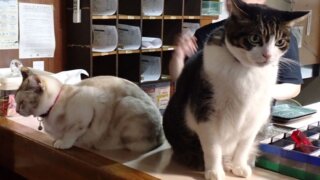The place is right next to Dazaifu Tenmangu Shrine of Fukuoka where many tourists visit from in and outside of Japan.
In Kyushu National Museum, there is an experiencing zone that not only kids but also adults can enjoy.
The name is “Asippa“.
This exhibition space, where you can not only “see” things related to Asian countries, but also touch, hit, and wear, is free admission.
Well, let’s experience completely the Asia.
Contents
Go Through Near-futuristic Tunnel From Dazaifu Tenmangu Shrine
 image by japan-local-guide.com
image by japan-local-guide.comKyushu National Museum opened as the fourth national museum in Japan.
There are various exhibition from the aspect that culture of Kyushu and Japan has been formed through interactions with Asia.
But, when you talk about a museum, you may have such images as “too formal to enjoy” or “hard to understand”
Please forget such images here.
There is a tunnel for access as one of the entrances to Kyushu National Museum, at the far end of the iris(Ayame-ike) pond of Dazaifu Tenmangu Shrine.
Going up a long escalator, you will see a tunnel, which is waiting as a next, of lights that change in rainbow colors.
When went through the tunnels, you will be massively welcomed by the museum building of beautiful curving shape, which is said that created with an image of waves in Genkainada, in the other side of the wide space.
As the sky and the landscape of Chikushi mountains are reflected on the side of building, you can feel as “the museum that is united with surrounding nature”.
Feel Asia Close, Full Using of Your Five Senses

Kyushu is the place where you cannot tell a story without telling about interactions with overseas, from the beginning of history of forming Japan as one nation.
At the ordinal exhibit corner, such items related to Japan’s interactions with Asian countries and Europe are exhibited with regular rotation.
Even at such ordinal exhibition, it is elaborated for you to feel history with your five senses, like touching, and smelling.
In “Asippa”, which is said that it was named from “Asia no Harappa (An open field in Asia)”, you can experience with more fun.
Anyways, on the official website, the spell is Ajippa, so please be careful.
It is a space where you can feel Asia closer, with a sense of more like “playing” than “learning”.
Experience Wearing the Ethnic Costumes
 image by yokanavi.com
image by yokanavi.comThough the exhibits change little by little, the theme as “experience the Asia” remains taken care of always.
Let’s look at the corner where you try wearing “saromb” of Indonesia.
It is not a jacket or trousers, and it is not like a kimono.
“Saromb” is one piece of cloth.
Then, how do you wear it?
There shows understandably how to wind, and also, there is always a curator in “Asippa”, so you can ask them to teach.
Wearing the ethnic costumes of Uzbekistan, you wear a hat as well.
During the Sengoku Era (from late 15th century through late 16th century). When Nobunaga Oda was active, there entered many Namban (South European Barbarians) culture to Japan from Portuguese and Spain.
It is also OK for you to wear mantles and hats that were wore by such Namban people.
Moreover, there prepared the photo shooting corner of Namban Byobu (the folding screen of Namban visitors to Japan).
Nobunaga Oda had much interests in the other countries.
If you and your kid wear black mantles and hats, you may be looked as if you are Sengoku warriors who tried wearing costumes of the different countries.
Don’t forget shooting photos in front of the Namban Byobu.
Who wins? Let’s Game With Asian Toys!

Also, you can not only see but also play with your hands toys inherited to the Asian countries.
Please for sure try magnetized big puzzles with a family or a group.
There shows explanation of how to play each game, so it must also be fun to fight.
It shall be a fun good memory of the trip that the time you think and ponder together, playing the game.
As though there are some games that are similar to that of Japanese and some are not similar at all, please feel experiencing the wideness and mystery of the Asia.
Let’s Sound Beautiful Tones.
There is “Asigalle (Asia + gallery)” at the far end of Asippa.
Here is a corner exhibited ethnic musical instruments of each country.
Of course, here also you can actually try playing them.
There is traditional music called gamelan in Indonesia.
As it is played by multiple instruments, it is like an orchestra if in Europe.
Instruments used for this gamelan are also exhibited.
Let’s confirm how tones change according to the sizes of drums by actually playing them.
Although there also is instrument looking alike the Western instruments, which you may have used in a music room of school, please try playing it actually and listening to how it sounds.
Please also feel the beauty of reverberation of the tones.
Summary
Do you now understand that Kyushu National Museum is an attractive museum where you can enjoy with your five senses?
There store many national treasures and important cultural treasures, so it is also the museum where exist fulfilling exhibition, which is also recommended to those who have interests in history and culture.
And, there are many original goods sold in a museum shop, so you can enjoy.
Miscellaneous goods with a motif of a bug that appears in a medical book of the Sengoku Era are humorous and cute, and these are popular because you cannot get them anywhere else.
With a family or a group, when you come to Dazaifu Tenmangu Shrine, please come and enjoy at Kyushu National Museum, too.










![11 Maid Cafe Ranking in Tokyo [Recommended even to beginners and ladies!]](https://jatrabridge.com/wp-content/uploads/slider/cache/11597c33ae53b47eb36a2f67968e635f/Maid-Cafe-Ranking-in-Tokyo2.3.jpg)









![Within 5-Minute Walk from Yatai! 7 Recommended Hotels to Choose in Nakasu/Tenjin Area [By Budget]](https://d3gy5wjocfgtwh.cloudfront.net/wp-content/uploads/2025/04/10200638/hotels-around-nakasu-fukuoka_0.jpg)













